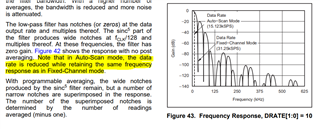Other Parts Discussed in Thread: ADS127L11
Hello,
I am using the ADS1258 in autoscan mode to mux through multiple input channels (up the full single ended channels at a time). I want to ensure that there is no aliasing of signals outside of the passband.
I understand (roughly) how the oversampling and digital filtering of a single channel delta-sigmal ADC reduces the requirements on the anti-aliasing filter... (here's a good link that I've often referred to: https://e2e.ti.com/blogs_/archives/b/precisionhub/posts/the-delta-sigma-advantage-to-anti-aliasing-filters)
What I don't understand however is how the MUX'ing the input (Autoscan mode) impacts (or does not impact) this behavoir.
As an example... Suppose I want to sample 16 channels with relevant frequency content of 200Sps.
So... In order to meet Nyquist theorem, my SPS needs to be at least 400Sps per channel (16 channels total)... So that means I need an aggregate Autoscan datarate of at least 6400SPS. Which can be achieved at a DATARATE = 0b10

Sounds good so far... But then I see that the datasheet states that the frequency response isn't different in Autoscan mode vs Fixed Channel Mode:

So I have a 3dB bandwidth of 12.4kHz but an output data rate per channel of only (15.123kHz / 16 channels = ) 945 Sps --
It seems to me that if I were to do an FFT of these samples... All of the content between 945Hz/2=473Hz and (at least) the 12.4kHz -3dB bandwidth (likely beyond this as -3dB is not much attenuation) would alias in... Or am I missing something?
So does this imply that we actually need a much steeper anti-aliasing filter at data rate / 2 to compensate for the fact that the digital filter isn't adjusted to account for the lower data rate associated with the MUX'd channels?
....
On a related note, I'm also struggling to conceptualize how the oversampling and digital filtering actually works when we are only focused on a given channel for a fraction of the time -- I think it ultimately plays into my above question, but I'm concerned that there is actually even more at play here that I am missing -- This question (unanswered) does a good job at summarizing this concern -- https://dsp.stackexchange.com/questions/17482/anti-aliasing-requirements-for-a-muxed-sigma-delta-converter
Thanks!


